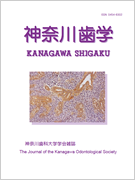- HOME
- > 一般の方
- > バックナンバー:神奈川歯学
- > 17巻4号
- > アブストラクト
アブストラクト(17巻4号:神奈川歯学)

Japanese
| Title : | 歯科用ミリングにおける切削条件について |
|---|---|
| Subtitle : | 原著 |
| Authors : | 原橋豊信 |
| Authors(kana) : | |
| Organization : | 神奈川歯科大学補綴学教室第一講座 |
| Journal : | 神奈川歯学 |
| Volume : | 17 |
| Number : | 4 |
| Page : | 494-513 |
| Year/Month : | 1983 / 3 |
| Article : | 原著 |
| Publisher : | 神奈川歯科大学学会 |
| Abstract : | 「緒言」 ミリングテクニックによって製作したパーシャルデンチャーは, 咬合圧の均等配分や衛生的効果ならびに審美的効果から歯科補綴領域において重要視されている補綴物である. 近年では材料や技術的精度の向上に伴い, さらにこれらが容易に製作されるようにシステム化が進んできている. ミリングテクニックは, Steiger, A. A. およびBoitel, R. H. により開発され, Gaerny, A., Korber, K. らの各方式がある. 本邦における臨床的研究は, 松尾, 津留, 丸山らにより多く報告され, 日本人に適した形態が松尾, 津留らによってほぼ確立し, 普及されてきている. このような中にあっても歯科におけるミリング操作の基礎的研究は少なく, 理想的なミリング条件について述べられているものは少ない. 本来, 製作面での理想的なミリングはパトリックスとマトリックスの適合性の向上を主体とし, ワックスグルーピングでは補償しにくい精度, すなわちアンダーカットを生じないこと, より滑沢な面が得られることなどを目的として行われる. |
| Practice : | 歯科学 |
| Keywords : |
English
| Title : | Cutting Conditions in Dental Milling |
|---|---|
| Subtitle : | |
| Authors : | Toyonobu HARAHASHI |
| Authors(kana) : | |
| Organization : | 1st Department of Prosthetic Dentistry, Kanagawa |
| Journal : | Kanagawa Shigaku |
| Volume : | 17 |
| Number : | 4 |
| Page : | 494-513 |
| Year/Month : | 1983 / 3 |
| Article : | Original article |
| Publisher : | Kanagawa Odontological Society |
| Abstract : | Abstract : Partial dentures produced by milling technics are a prosthesis being viewed with importance in the field of prosthodontics because of the balanced distribution of occlusal pressure as well as hygienic and esthetic results. Essentially, the ideal milling technic has concentrated on improving the fitness of the patrix and matrix. Milling has been performed in order to compensate for with wax grooving which are difficult to avoid undercuts as well as to achieve a smoother surface. Also important and having a direct bearing on this is favorable cutting efficiency which depends on the conditions for the cutting instrument and the material to be cut. Considering milling from this point of view, the factors which come into play are extremely numerous making it dillicult to obtain favorable milling conditions. The authors have already made six reports on basic research in metal cutting under various conditions. This has included discussion of matters such as a) types of cutting tools, b) tool-life, c) cutting efficiency, d) cutting structure, e) types of dental Pt-Au alloy for milling and their cutting properties and f) hardening of material during cutting. This has resulted in basic information on these matters. This present study made use of the above results in order to clarify the conditions necessary for milling based on the relationship among factors such as number of cuttIng teeth, cutting speed, feed speed and depth of cut. Results were as follows. (1) Best conditions for achieving a smooth milled surface were low cutting speed (about 33m/min.) and several cutting teeth (20 teeth). Feed speed (2~18mm/sec.) did not seem to have much influence. (2) Conditions which displayed favorable cutting efficiency were high cutting speed (about 99m/min.), few cutting teeth (12 teeth) and high feed speed (18mm/sec.). (3) In carrying out appropriate milling it is considered desirable to make a distinction between the cutting conditions listed in (1) and (2) above depending on the desired results. |
| Practice : | Dentistry |
| Keywords : |
